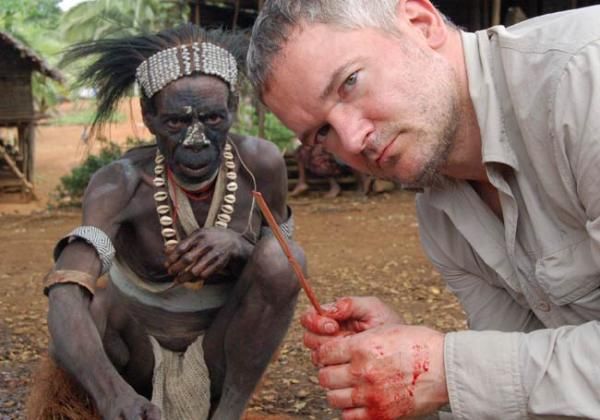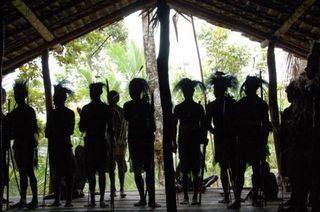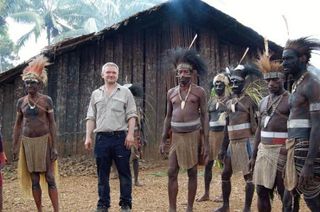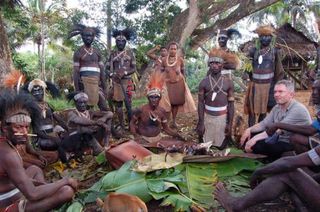
Ultimate Taboo: Exploring World of Cannibals

New Yorkers are a notoriously unflappable bunch yet on a recent afternoon, one gentleman at a local eatery may have caused even the most hardened among the lunchtime crowd to pause over their burgers and salads.
"I hope that is the only time I ever eat a pig's eyeball. I did not enjoy it in any way whatsoever," said Piers Gibbon, as he worked away at his very first New York pizza with a knife and fork.
Gibbon elegantly mannered, vaguely impish, very British spent his lunch hour amiably discussing cannibalism, human consumption and scenes of butchery over spinach pizza and tea, as an upbeat soundtrack of Donna Summer and Earth, Wind & Fire played in the background.
Handsomely dressed in a crisp button-down, with close-cropped silver-flecked hair and a pleasantly telegenic face, the author, explorer and television host looked right at home among the well-heeled diners.
Yet Gibbon is best known for spending time in less comfortable locales. For his most recent program, "Eating With Cannibals" on the National Geographic Channel, Gibbon supped and lived with people who, until the last few decades, killed and ate other humans.
Gibbon spent a month among the Samo and Biami people, an adventure that took him, via smaller and smaller airplanes, and finally on foot, to Papua New Guinea's wild interior, a place where some tribes still live in near isolation.
During his journey, Gibbon and a small film crew lived the local way rising at dawn, fording rivers on foot, and sleeping on mats on the floor of a village longhouse, trying to fall asleep to the sound of pigs getting romantic at night, he said.
Sign up for the Live Science daily newsletter now
Get the world’s most fascinating discoveries delivered straight to your inbox.
The finished product is a 50-minute exploration of a culture where the ultimate taboo humans killing and eating other humans is not a subject to inspire horror and revulsion, but instead was once an accepted part of life.
"It's a fine line to tread between seeing just that which is shocking and trying to put it into context," Gibbon said. Yet, that is precisely what he aimed to do, he told OurAmazingPlanet.

Strange interests
A veteran of similarly adventurous documentaries filmed around the globe, Gibbon has delved into other bizarre aspects of human cultures, including head shrinking and medicinal rituals with horrifying side effects.
"I'm interested in the strange," Gibbon said, but emphasized that his interest isn't fueled by a desire to sensationalize practices that can seem gruesome to outsiders, but, in fact, to humanize them.
"I think it's OK to have that first response to the strange be, 'Wow, that is not something I would ever do, I don't want anything to do with it,'" Gibbon said. "But I think by looking at something and trying to find out why it's not so strange in that culture, you can learn about the whole culture."
One of the first things Gibbon learned during his most recent quest was that, among those who once practiced cannibalism, the subject isn't an uncomfortable one.
"We were very sensitive in the beginning to keep this as a gentle agenda rather than marching in with a big sign and saying, 'Tell us about the people meat!'" Gibbon said. However, much to his surprise, "They were very happy to talk about it."

Cannibal culture
During his time in Papua New Guinea, Gibbon sat down with men, all about Baby-Boomer age, who described, with utter calm, killing people and eating them.
One Biami man described killing two women, to honor the dying wish of a husband who suspected his wife and her friend of saying bad things about him, things that he thought caused his sickness.
The man said they roasted the women over the fire, just like pigs, to burn the hair off, and cut up their flesh and ate it.
"It's a scene of psychopathic horror through our eyes, but to him it was something that happened in the past, and it's perfectly explainable to him," Gibbon said.
In addition, Gibbon sought out one of the last known "song leaders" of the Biami, a man whose spirit guide, whom he described as a beautiful young woman, would appear to him during all-night, villagewide singing rituals, and tell him the name of someone who was doing bad magic. Once named by the song leader, the person would be killed and eaten.
"He had the absolute power of life and death over everyone in the surrounding area," Gibbon said although it has been several decades since cannibalism in any form has been practiced in the region.
And although the camera captured some chilling conversations, Gibbon said some of the best parts of his journey happened off-screen. He and the crew spent a lot of time playing with the children in the villages they visited, and even took part in some musical jam sessions. Gibbon is an expert on the Jew's harp, and the Biami also play a version of the instrument.
"It was just a really lovely cross-cultural exchange," Gibbon said.
But back to the pig's eyeball.

A dubious honor
The Biami killed a pig in honor of Gibbon's visit an enormous honor among a people for whom food is scarce, and meat is even more of a rarity.
Gibbon was allowed to help butcher the animal and treated to one of the best cuts. And the eyeball, which he barely choked down.
"They quite enjoyed the fact that I coughed it out again," Gibbon said, laughing. And in the end, he says, that's what made the whole experience possible and allowed for understanding between groups that might seem to have nothing in common.
"I find if you have a sense of your own ridiculousness, it helps," Gibbon said. "We're from other sides of the planet from each other, yet we can play the same musical instrument and have a laugh."
With his tea finished, the intrepid adventurer headed out into the cold and rainy New York afternoon, yet not before confiding that he was in for an encounter in a few hours that was a bit intimidating, even for him.
"I'm nervous," Gibbon said. "And excited."
He was scheduled to be the guest on the Colbert Report later in the evening. Gibbon said he'd had to buy a jacket for the occasion. Explorers travel light.
Catch "Eating With Cannibals" tonight (Apr. 4) at 8 p.m. ET on the National Geographic Channel. The program kicks off the channel's Expedition Week.
- The World's Scariest Places
- In Images: Extreme Living â?? Scientists at the End of the Earth
- Not-so-Dangerous: Encounter with Nat Geo Host
Reach Andrea Mustain at amustain@techmedianetwork.com. Follow her on Twitter @AndreaMustain.











